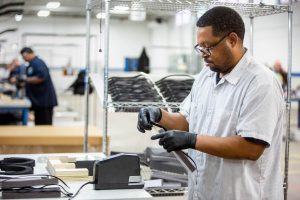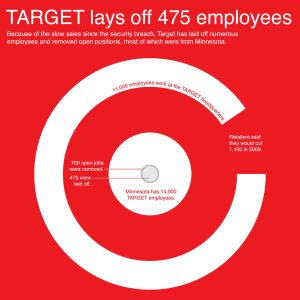3M Lays Off Nearly 3,000 Employees Worldwide
Local 3M worker stands outside a 3M building. This building has active workers inside. It is one of many locations that will be laying workers off.
January 24, 2021
“Especially because people don’t know, it does create a lot of stress. My advice is always: you just don’t want to borrow the stress, ‘til it happens to you, and then you have to figure it out. But in that uncertain time, there’s really not much you can do, so kind of try not to focus on that. Because, odds are you’re going to come through it. You’ll never know, you’ll never really find out who was affected unless you know them personally. There is never a grand announcement about who left the company, so it’s more of a quiet kind of thing,” Erik Vanstrum, a Global Labs Manager at 3M, discussed what a period of time that involves a mass layoff can be like.
This is something that is ongoing within the company on a global scale as 2,900 employees are in the process of getting laid off. This roll out of layoffs was announced at the beginning of December as part of a progressing initiative to restructure the company amidst the global pandemic. This restructuring intends to streamline the company and increase their focus on markets that have shown to be resilient through the pandemic. Laying employees off is one step of that process.
At the beginning of December, 3M announced it would lay off another 2,900 employees globally due to the surging pandemic and suffering economy. This will cut 3% of their workforce globally. The restructuring will impact any and all geographies, business groups, and functions.
Laying off employees is not an unusual thing, but it does differ from firing. While getting fired is typically the employee’s fault, layoffs are considered the company’s fault. Additionally, layoffs involve more than one employee losing their job at once, whereas getting fired is individual.
On the topic of periods of layoffs, Vanstrum said, “It’s kind of a natural cycle of companies,” and “they typically do it as a way to keep a particular business healthy. Certain businesses are kind of ebb and flow in terms of profitability and business cycle and all this other stuff. So, it’s a constant adjustment I think they’re making.”
This layoff was already in the works as part of an ongoing plan to streamline the company. A restructuring process that will cost the company up to $300 million. This restructuring is part of an effort to adapt and be flexible, and aid the company in coming out of the pandemic stronger. The company will focus more on customer support and marketing capabilities.
“Companies are always trying to beat everybody else in terms of being a good investment, so they’re manipulating all their assets and people to leverage that. A company can have explosive growth, when they’re in a good position, and they’re hiring people and investors are making money and they’re pumped. It’s just when you kind of hit the point where growth – actually, even if you decline and grow in those areas – it’s usually their start of looking at what levers they can pull,” Vanstrum explained his take on how companies decide when and who to layoff. He mentions factors such as investors, economic state, and markets that have either a rapid or slow growth. All of these elements, and more, are things that companies such as 3M take into consideration all the time, but more specifically quarterly, when making decisions related to layoffs.
3M is a multinational conglomerate, or multi-industry, that is headquartered in Maplewood, which is only 15-20 minutes away from our high school. Because it is a Minnesota-based company, it employs a fair amount of Minnesotans. As such, it is not uncommon to know someone who works at 3M. The company actually employs over 90,000 employees, over 10,000 of which are located in Minnesota. Understanding both the local and global scale aids in the understanding of both the company’s perspective as well as the employee’s perspective. As the company decides what sectors to prioritize and which to downsize, the individual employees rely on their job as income and their livelihood.
“I think some of it is probably the fiscal year. You know, trying to make sure you’re positioning the company right and of course, they’re looking at what investors are doing too,” Vanstrum added. “It’s not always the most fun, and of course, you know, it’s stressful for people in that time period.”
3M already laid off 1,700 employees at the beginning of August, and laid off 1,500 in January of 2020. The layoffs, or at least the ones that have not already happened, will likely occur mostly in January and go into February as that is the period of time when most layoffs are generally made. This is because of the fiscal year-end/year-beginning.
Vanstrum said that, typically, when employees get laid off, they are provided with a compensation package. This is meant to soften the blow of unemployment and get them through the period of time when they are finding a new position.
He explained, “I think the year end stuff is probably typical because of the fiscal calendar … I think the external environment of the economy, and just kind of looking at all those economic numbers they tend to roll out quarterly, because all the companies report quarterly. So I would think they’re kind of those areas where they’re getting lots of data quarterly throughout the year, they make those decisions.”
The plan to streamline the company focuses on prioritizing markets that have shown to be resilient and buoyant in the midst of the pandemic, such as personal safety, home improvement, and e-commerce. At the same time that they capitalize on these persisting markets, they will be reducing redundancies in sectors that they deem sluggish. To the overall company, these redundancies are dead weight, but remember that each of these employees are people with families and their job is a source of income. To the company, they need to cut down, but to the employee, it is how they make a living.
“It’s partly a survival tactic for companies, because they have to, obviously, remain profitable. So, it’s typically a reaction to softening economies and slower business,” Vanstrum added. “[The pandemic] has definitely impacted 3M, but 3M is very diverse, so certain parts of the company are really strong: respirator areas and medical areas are working 24/7.”
3M is in the process of transformation as it continues to take actions that progress its growth. The streamlining and restructuring of the company means that hard decisions have to be made, as we remember that these 2,900 employees have lives and their job is their source of income. This restructuring will cost the company, but the goal in the end is that they will be more efficient in areas where it is necessary, and that they are then able to come out of this pandemic stronger than before. Cutting these jobs puts employees in a stressful period of time, so one can hope that they receive good compensation packages. Whereas, for the overall company, they are eliminating redundancies and improving efficiency. Taking both into consideration, all anyone knows is that everyone is trying their best to make it through this pandemic.











